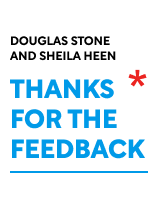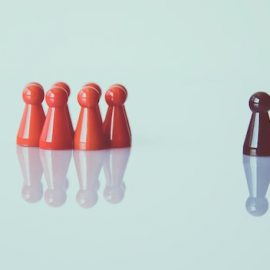

This article is an excerpt from the Shortform book guide to "Thanks for the Feedback" by Douglas Stone and Sheila Heen. Shortform has the world's best summaries and analyses of books you should be reading.
Like this article? Sign up for a free trial here .
What constitutes effective feedback? How can you ensure that your feedback is acted upon?
According to Douglas Stone and Sheila Heen, the authors of Thanks for the Feedback, there are just two elements of feedback: 1) the looking-back element, and 2) the looking-forward element. To ensure your feedback is taken on board, make sure that the receiver understands both parts.
Here is how to structure feedback to ensure both the giver and the receiver are on the same page.
Feedback Has Two Elements
There are two elements of feedback: an element looking back (here’s what I think) and an element looking forward (here’s what you should do). When the receiver of feedback does not properly understand exactly what experiences, values, and biases are producing the feedback, or what its explicit goal is, she tends to dismiss it as “untrue.”
1) Where the Feedback Is Coming From
The first part of feedback, the looking-back piece, is made up of a combination of data and interpretation of that data.
Data
Feedback begins with data—observations that a person makes about you. Observations can be about anything, including your actions, statements, clothing, work habits, or even rumors about you. Though “data” sounds objective, observations are quite subjective. Different people pay attention to different data they come across because of variables in access, priorities, and biases.
- Different access: Your position in an organization or your relationships to other people affect what information you have access to. (Your boss knows what your colleagues are paid but you don’t. The receptionist hears gossip the CEO doesn’t.)
- Different priorities: Even when we have access to the same data, our differing life experiences and priorities cause us to notice different things. (We may all walk down the same street, but the weekend cyclist will notice the bike path, while the woman with a cane will see the access ramps.)
- Different biases: We tend to notice things that confirm our pre-existing emotional connection to something. (If we like a person, we’ll notice the good things she does. If we don’t, we may ignore those good things and focus on the time she messed something up.)
Problems arise when two people approach feedback with two different sets of data. For example, a marketing team might object to the amount of push-back their legal counsel gives their marketing materials. The marketing team is looking at data from other companies, watching as their competitors put out messages faster and with less legal oversight. Their counsel, though, has access to different data. She sees litigation reports that show how costly it can be when a company gets caught up in legal problems its counsel could have anticipated.
Interpretations
Interpretations are the emotions, judgments, and values that people attach to their observations. Interpretations are also subjective, influenced by different rules, points of view, and (again) biases.
- Different rules: We each approach life with an assumption of a basic set of rules—a set of standards and operating principles that govern our behavior. Organizations, regions, and families also have their own sets of rules, which create that body’s culture. You may think of these rules as “the” rules, while they really may just be “your” rules.
- Problems arise when two people are following different sets of rules and not realizing they’re different. One company may value blunt honesty, while a second company may place a higher value on tact. Someone who moves from the first company to the second may find that her management style, once highly appreciated, no longer gets the same results. Two roommates may clash because the first assumes everyone aims to live in a well-organized house, while the second feels clutter is a normal part of life.
- Different points of view: Everyone sees themselves as the hero of their particular story, and they see other people as supporting characters or worse, villains.
- A daughter may be upset to see her mother in great pain after a surgery and may demand her mother receive painkillers, as her data tells her that her mother has a very high tolerance for pain, so this visible pain must be horrendous. The doctor may refuse, as her data tells her the dangers of opioid addiction and that this particular pain should resolve quickly. Both the daughter and the doctor feel like the hero, protecting the mother. They may very well also see each other as the villain.
- Different biases: Just as biases influence what data we pay attention to, they also influence how we interpret that data.
- If we like a person, we might applaud her “willingness to take risks,” whereas if we don’t, we might caution that those same actions are “unnecessarily risky.”
- We are also biased to favor our own actions in comparison to others’: The vast majority of drivers believe they are above-average, and the vast majority of managers believe they are in the top ten percent.
Conflicts happen not only when each party follows a different set of rules, values, and assumptions, but also when each believes hers are more correct than the other persons’. To find common ground, we must recognize that different people have different “truths”: Your views on another person are subjective and your data and interpretations are not necessarily more correct than other peoples’.
2) Where the Feedback Is Going
The second major element of feedback is the forward-looking piece. If the feedback is coaching, the forward-looking element is about advice (“You need less salt in this dish”). If the feedback is evaluation, the forward-looking piece is about consequences and expectations (“You aren’t allowed to cook for my parents again”).
The Dangers of Labels
You can’t properly understand feedback without understanding the labels through which it is typically delivered.
The process of moving from observation to interpretation happens fairly instantaneously and unconsciously; it’s how our brains work. Therefore, we are often unaware that it has happened. When we throw out an interpretation while thinking it’s an observation, we create a “label.”
Labels are shorthand for feedback. They are usually pithy phrases that sum up a person’s thoughts but are vague and open to interpretation (and misinterpretation). For example, “Be more assertive” is a label that can be interpreted in different ways.
Because labels are vague, we often supply our own interpretation to them, which can lead to problems if it doesn’t match what the person was actually trying to say. We may hear “be more assertive” and think it means “hound the customer better for a sale,” when in fact it means “act more energetic and engaging.” “Be more affectionate” might mean “hold hands in public,” but it could also mean “initiate sex more often.”
Labels are triggering because we read into them meanings that catch us emotionally. To prevent such a trigger, make a habit of identifying labels and resisting the urge to supply your own meaning. Instead of fixating on the label, try to figure out what’s behind it, and where the feedback is coming from.

———End of Preview———
Like what you just read? Read the rest of the world's best book summary and analysis of Douglas Stone and Sheila Heen's "Thanks for the Feedback" at Shortform .
Here's what you'll find in our full Thanks for the Feedback summary :
- How to better receive feedback, rather than just giving it
- Why people tend to respond negatively towards feedback
- How to successfully incorporate feedback into your life






